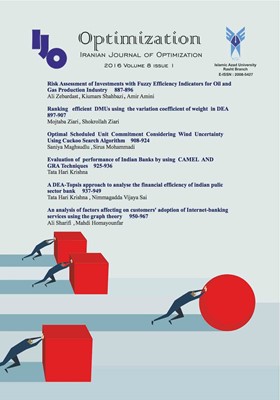Risk Assessment of Investments with Fuzzy Efficiency Indicators for Oil and Gas Production Industry
Subject Areas : Mathematical EngineeringAli Zebardast 1 , Kiumars Shahbazi 2 , Amir Amini 3
1 - Department of Economic, Faculty of Economic and Management, Urmia University, Urmia, Iran
2 - Department of Economic, Faculty of Economic and Management, Urmia University, Urmia, Iran
3 - MSc. Graduate of Industrial Engineering, Alghadir institute of higher education, Tabriz, Iran
Keywords: investment, decision making, fuzzy theory, criteria, Risk Assessment, risk zone,
Abstract :
In the process of investment decision making, next to financial indicators many other aspects of investment projects are increasingly often considered. This leads to the multi-criteria evaluation of a project. The advantage of multi-criteria methods is the ability to take into account all (not only financial) aspects of the attractiveness of an investment project. The selection of criteria of project assessment must take into account the specificity of organization that makes a decision. Along with traditional method this paper introduces new approach for risk assessment based on each criterion characterizing the investment project on hydrocarbon resources exploitation.
Rębiasz, B., & Macio, A. (2014). Hybrid data in the multi objective evaluation of investments. Procedia Computer Science, 35, 624 – 633.
Nedosekin, A.O. (2003). Methodology foundations of modeling of the financial activities by using of fuzzy description, St. Petersburg, Russia.
Pashayev, R.T., Mamedov, K.S., & Valiyev, V. M. (2014). Quality criterion selecting best project investment, social finance and IT magazine –international conference, Baku pages, 100-104.
Andreu Mas-Colell Michael, D., Whinston, & jerry, R. (1995). Green Microeconomic Theory. New York Oxford,Oxford University.
Rębiasz, B. (2013). Selection of efficient portfolios-probabilistic and fuzzy approach. comparative study. Comput. Ind. Eng, 64, 1019–1032.
Ustundag ,A., Kılınç ,M.S., & Cevikcan, E. (2010). Fuzzy rule-based system for the economic analysis of RFID investments. Expert Systems with Applications, 37, 5300–5306.
Agrell ,P., Bogetoft, P.,& Mikkers ,M. (2013). Smart-grid investments, regulation and organization. Energy Policy, 52, 656–666.
Podgórski, D. (2015). Measuring operational performance of OSH management system–A demonstration of AHP-based selection of leading key performance indicators. Safety Science, 73, 146–166.
Saaty ,T. (1980). The analytic hierarchy process. New York: McGraw Hill.
Merino, J. P. (1995). R & D Project Selection. New York: Wiley.
Archer, N. P.,& Ghasemzadeh, F. (1999). An Integrated framework for project portfolio selection. Int. J. Proj. Manag, 7, 207-216.
Van Laarhoven ,P.J.M.,& Pedrycz, W. (1983). A Fuzzy Extension of Saaty’s Priority Theory. Fuzzy Set Syst, 11, 229–241.
Buckley, J. J. (1985). Ranking alternatives using fuzzy numbers. Fuzzy sets and systems, 15, 21-31.
Buckley ,J. J. (1989). A fuzzy ranking of fuzzy numbers. Fuzzy sets and systems, 33, 119-121.
Buckley ,J. J., & Chanas ,S. (1989). A fast method of ranking alternatives using fuzzy numbers. fuzzy sets and systems, 30, 337-338.
Chang ,D. Y. (1996). Applications of the Extent Analysis Method on Fuzzy AHP. Eur. J. Oper. Res, 95, 649–655.
Chanas, S., & Zielinski, P.( 1999). Ranking fuzzy interval numbers is the setting of random sets. further results, information sciences, 117, 191-200.
Lootsma, F. A. (1997). Fuzzy Logic for Planning and Decision Making. Dordrecht: Kluwer Academic Publishers.
Ruoning, X., & Xiaoyan, Z. (1992). Extension of the Analytic Hierarchy Process in Fuzzy Environment.Fuzzy Set Syst , 52: 251–257.
Pan, Y. (1997). Revised Hierarchical Analysis Method Based on Crisp and Fuzzy Entries. Int. J. Gen. Syst., 26,115–131.
Enea, M., & Piazza, T. (2004). Project Selection by Constrained Fuzzy AHP. Fuzzy Optimization and Decision Making, 3, 39–62.
Chan, F.T.S., Chan, M.H., & Tang, N. K. H. (2000). Evaluation methodologies for technology selection. J. Mater. Process Tech, 107, 330-337.
McKown, A. K., &Mahomed, S. (2001). Modeling project investment decisions under uncertainty using possibility theory. Int. J. Proj. Manag , 19, 231-241.
Liu, P., Zhang, X.,& Liu, W. (2011). A risk evaluation method for the high-tech project investment based on uncertain linguistic variables, Technol Forecast Soc, 78: 40–50.
Zadeh, L. A. (1988). Fuzzy logic Computer, 21, 83–93.
Braya, S., Caggiania, L., & Ottomanelli, M. (2015). Measuring transport systems efficiency under uncertainty by fuzzy sets theory based Data Envelopment Analysis: theoretical and practical comparison with traditional DEA model. SIDT Scientific Seminar.Transportation Research Procedia, 5, 186 – 200.
Shavandi, H. (2005). Fuzzy sets theory and its application in industrial engineering and management. Gostareshe Olome Payeh publication, Tehran.
Liu, P., Zhang, X., & Liu, W. (2011). A risk evaluation method for the high-tech project investment based on uncertain linguistic variables. Technol Forecast Soc, 78, 40–50.

